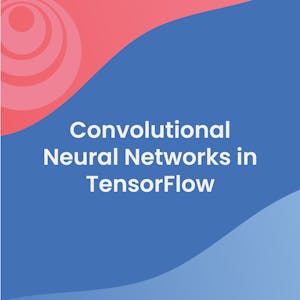Convolutional Neural Networks in TensorFlow
If you are a software developer who wants to build scalable AI-powered algorithms, you need to understand how to use the tools to build them. This course is part of the upcoming Machine Learning in Tensorflow Specialization and will teach you best practices for using TensorFlow, a popular open-source framework for machine learning.In Course 2 of the deeplearning.ai TensorFlow Specialization, you will learn advanced techniques to improve the computer vision model you built in Course 1. You will explore how to work with real-world images in different shapes and sizes, visualize the journey of an image through convolutions to understand how a computer “sees” information, plot loss and accuracy, and explore strategies to prevent overfitting, including augmentation and dropout. Finally, Course 2 will introduce you to transfer learning and how learned features can be extracted from models.
The Machine Learning course and Deep Learning Specialization from Andrew Ng teach the most important and foundational principles of Machine Learning and Deep Learning. This new deeplearning.ai TensorFlow Specialization teaches you how to use TensorFlow to implement those principles so that you can start building and applying scalable models to real-world problems. To develop a deeper understanding of how neural networks work, we recommend that you take the Deep Learning Specialization.
Handle real-world image data
Explore strategies to prevent overfitting, including augmentation and dropout
Learn transfer learning and how learned features can be extracted from models
Syllabus
Syllabus - What you will learn from this course
Week 1
Exploring a Larger Dataset
Week 2
Augmentation: A technique to avoid overfitting
Week 3
Transfer Learning
Week 4
Multiclass Classifications
FAQ
When will I have access to the lectures and assignments?
Access to lectures and assignments depends on your type of enrollment. If you take a course in audit mode, you will be able to see most course materials for free. To access graded assignments and to earn a Certificate, you will need to purchase the Certificate experience, during or after your audit. If you don't see the audit option:
The course may not offer an audit option. You can try a Free Trial instead, or apply for Financial Aid.
The course may offer 'Full Course, No Certificate' instead. This option lets you see all course materials, submit required assessments, and get a final grade. This also means that you will not be able to purchase a Certificate experience.
What will I get if I subscribe to this Certificate?
When you enroll in the course, you get access to all of the courses in the Certificate, and you earn a certificate when you complete the work. Your electronic Certificate will be added to your Accomplishments page - from there, you can print your Certificate or add it to your LinkedIn profile. If you only want to read and view the course content, you can audit the course for free.
Reviews
Excellent material superbly presented by world-class experts.
Sorry if this sounds sycophantic, but this series contains some of the best courses I've encountered in50+ years of learning.
The course was fine sometimes I feel too easy. I would like to see more of the available options for the layers, such as padding, stride. filter size, mean average, batch normalization, etc...
This course awesome, but the notebook from coursera "i think" doesn't support any experiment we want, so we have to do it on google colab. But great, limitation is okay as long it's still graded
A really good course that builds up the knowledge over the concepts covered in Course 1. All the ideas are applicable in real world scenario and this is what makes the course that much more valuable!
